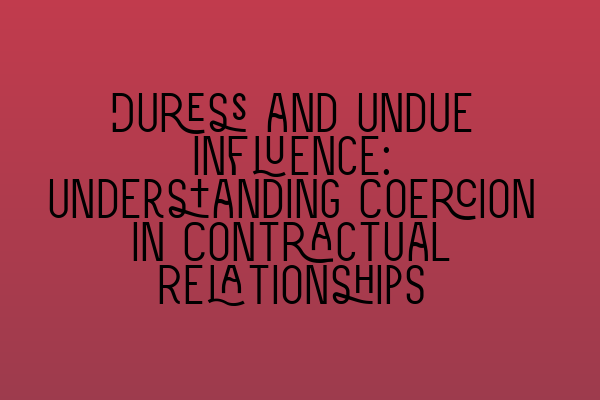Duress and Undue Influence: Understanding Coercion in Contractual Relationships
Contractual relationships are the foundation of modern business transactions, providing a legally binding agreement that ensures both parties fulfill their obligations. However, there are instances where contracts may be entered into under coercion or undue influence, compromising the fairness and integrity of the agreement. In this article, we will explore the concepts of duress and undue influence, shedding light on the subtleties and complexities involved in identifying and addressing these issues.
What is Duress in Contract Law?
Duress refers to a situation where one party compels another to enter into a contract against their will through the threat of force, harm, or other forms of coercion. The essential element of duress is the absence of free will, as the coerced party feels compelled to agree to the contract due to fear of consequences or harm.
Examples of duress include physical violence or threats, blackmail, economic pressure, and unlawful detention. It is important to note that duress can manifest in various forms, and the level of coercion necessary to render a contract voidable may vary based on the circumstances and the vulnerability of the coerced party.
Applying the Doctrine of Undue Influence
Undue influence is another form of coercion that occurs when one party exerts an unfair degree of influence over another, exploiting their vulnerability or trust to gain superior bargaining power. Unlike duress, undue influence does not involve direct threats or physical violence, but rather manipulates the decision-making process of the weaker party.
Undue influence is typically categorized into two forms: actual undue influence and presumed undue influence. Actual undue influence refers to situations where there is clear evidence of unfair persuasion or manipulation, while presumed undue influence arises when there is a recognized relationship of trust and confidence, such as between a lawyer and a client, or a parent and a child.
Identifying Coercion: Factors to Consider
Determining whether duress or undue influence played a role in a contractual agreement can be a complex task. Courts consider several factors when assessing the presence of coercion, including:
1. Timeliness: Was the contract signed under immediate pressure, with no reasonable opportunity for the coerced party to seek advice or consider alternative options?
2. Vulnerability: Did the coerced party have a diminished capacity to resist or understand the terms of the agreement due to age, mental incapacity, or other factors?
3. Unconscionability: Is the contract grossly unfair or one-sided, significantly favoring the party exerting coercion?
4. Relationship of Trust: Was there a pre-existing relationship of trust or dependency that could have been exploited by the party exerting undue influence?
5. Confidentiality: Did the coerced party disclose confidential information to the other party that was then used to influence the decision-making process?
The Legal Consequences of Coercion
If a contract is found to have been entered into under duress or undue influence, it may be rendered voidable at the option of the coerced party. This means that the coerced party has the right to rescind the agreement and be released from its obligations. However, it is important to note that the burden of proof lies with the coerced party, who must provide evidence of coercion in court.
As legal professionals, it is crucial to understand the nuances of duress and undue influence to effectively represent clients involved in contractual disputes. By recognizing the signs of coercion and gathering relevant evidence, solicitors can build strong cases to protect the interests of their clients and ensure that justice prevails.
Navigating Legal Challenges and Pitfalls in Your Practice
To further enhance your understanding of contract law and related topics, we invite you to explore these articles:
– Navigating Legal Challenges and Pitfalls in Your Practice: This article provides valuable insights into common legal challenges faced by solicitors and offers practical strategies to overcome them.
– Barrister vs. Solicitor: A Comprehensive Comparison: Discover the similarities and differences between barristers and solicitors, allowing you to make informed career choices and better serve your clients’ needs.
– Exploring Different Solicitor Specializations: Finding Your Niche: Learn about the various specializations within the field of law, helping you identify your area of expertise and excel in your chosen field.
– Embracing the Rise of Virtual Law Practices: Explore the benefits and challenges of virtual law practices, staying ahead of the curve in an increasingly digital world.
– Navigating the Maze: Demystifying Ethical Responsibilities of Solicitors: Gain clarity on the ethical responsibilities that solicitors must uphold in their practice, maintaining professionalism and integrity at all times.
Understanding the complexities of duress and undue influence in contractual relationships is essential for all solicitors. By continually expanding your knowledge and staying updated on legal developments, you can effectively navigate the challenges and pitfalls that may arise in your practice.
